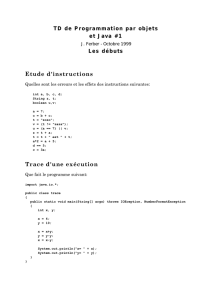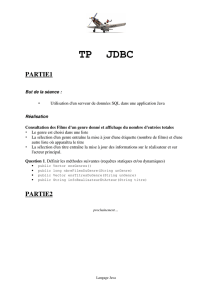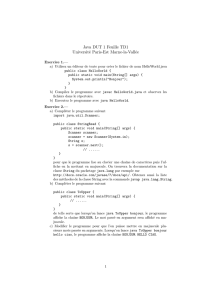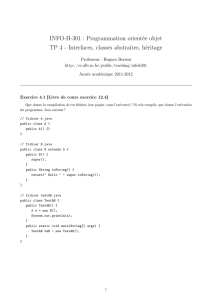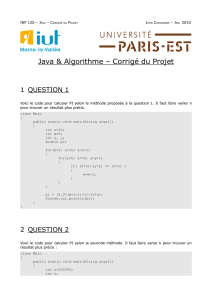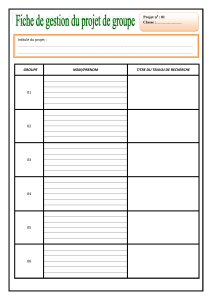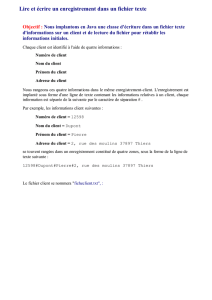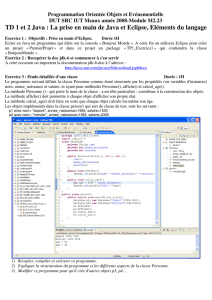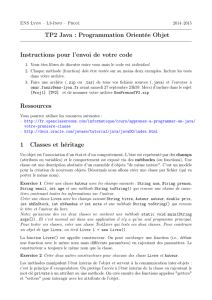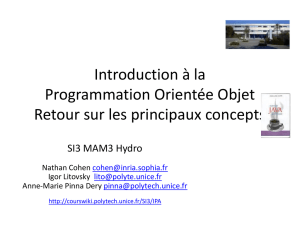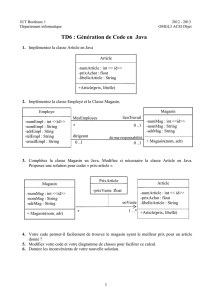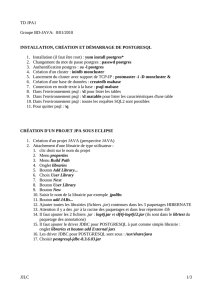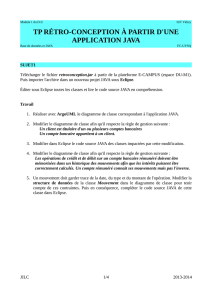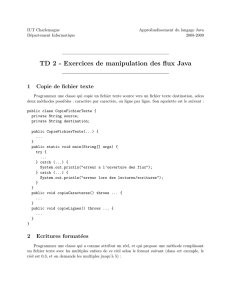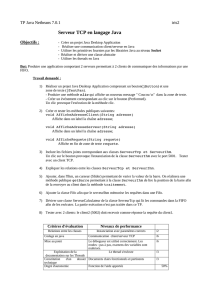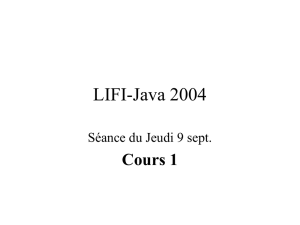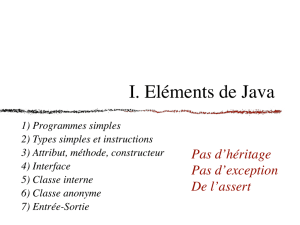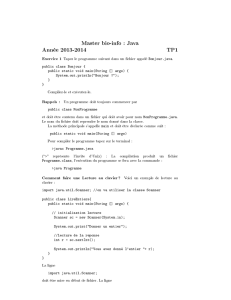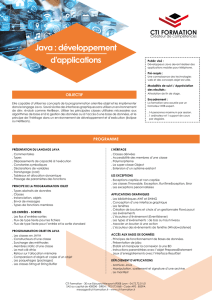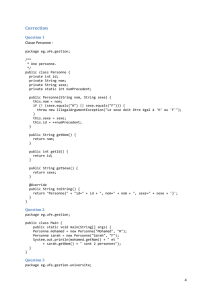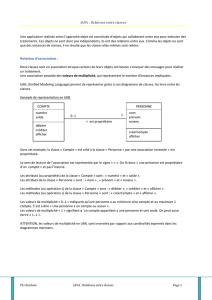Cours 5 Programmation objets : en Java
publicité
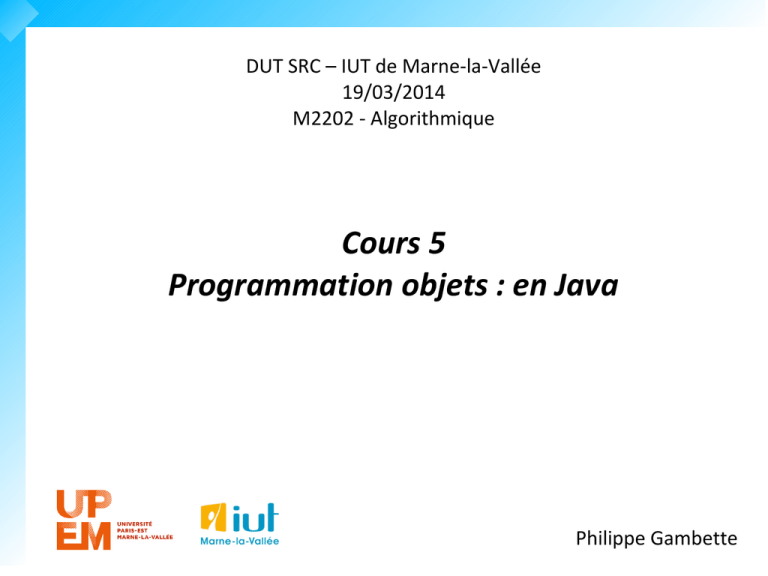
DUT SRC – IUT de Marne-la-Vallée
19/03/2014
M2202 - Algorithmique
Cours 5
Programmation objets : en Java
Philippe Gambette
Sources
• Cours d'Anne Tasso à l'IUT de Marne-la-Vallée
• Le livre de Java premier langage, d'A. Tasso
Rappels : Modélisation objets
Quelles caractéristiques / attributs ? “propriétés”
Composants d'une page web
Etudiants d'une classe
Quels comportements / actions ? “méthodes”
Rappels : Protection des données
Principe d'encapsulation
e
priva
Propriétés
Méthodes
set
Changer /
attribuer
une note
privat
te
private
Méthodes
get
Récupérer
une note
private
Syntaxe Java
Utiliser une classe depuis une autre (exemples de TP précédents)
public static Color couleurRGB(int r,int g,int b){
return new Color(r,g,b);
}
public static void dessineRectanglePlein(Graphics g,
int abscisseCoin,int ordonneeCoin,int largeur, int hauteur,
Color couleur) {
g.setColor(couleur);
g.fillRect(abscisseCoin, ordonneeCoin, largeur,
hauteur);
}
Syntaxe Java
Utiliser une classe depuis une autre : la classe Etudiant
public class BilanSemestre{
version
du cours
//Création d’un nouvel étudiant en fournissant les informations
Etudiant etu1 = new Etudiant("Maxime","Blanchard",
new float[5],1);
//Création d’un nouvel étudiant sans fournir les informations
Etudiant etu2 = new Etudiant();
//Afficher le nom de l’étudiant 2 :
System.out.println(etu2.getNom());
//Entrer les notes de l’étudiant 1 :
etu1.changerNote(0,14);
etu1.changerNote(1,12);
etu1.changerNote(2,18);
etu1.changerNote(3,14);
etu1.changerNote(4,13);
//Afficher les informations sur l’étudiant 1 :
etu1.affiche();
}
Syntaxe Java
Définir une nouvelle classe
public class Etudiant{
}
Syntaxe Java
Définir une nouvelle classe
public class Etudiant{
private String prenom;
private String nom;
private String[] notes;
}
version
minimaliste
public Etudiant(String pr, String no, String[] n){
setPrenom(pr);
setNom(no);
setNotes(n);
}
public void setPrenom(pr){
prenom=pr;
}
public void setNom(no){
nom=no;
}
public void setNotes(n){
notes=n;
}
public String afficheEtudiant(){
System.out.println("Prenom :"+prenom+" - Nom : "+nom+
" - Notes"+afficheTableau(notes));
}
Syntaxe Java
Définir une nouvelle classe
public class Etudiant{
private int id;
private String prenom;
private String nom;
private float[] notes; // 5 cases car 5 notes
version
du cours
//Constructeur avec informations fournies en entrée
public Etudiant(String pr, String no, String[] n, int i){
prenom=pr;
nom=no;
notes=n;
id=i;
}
[…]
//Constructeur sans informations fournies en entrée
public Etudiant(){
Scanner buf = new Scanner(System.in);
System.out.println("Nouvel etudiant :");
System.out.println("Prenom ?"); prenom=buf.next();
System.out.println("Nom ?"); nom=buf.next();
notes=new float[5];
System.out.println("Numero ?"); id=buf.nextInt();
}
Syntaxe Java
Définir une nouvelle classe
public class Etudiant{
[…]
//Méthodes get
public String getPrenom(){
return prenom;
}
public String getNom(){
return nom;
}
public float[] getNotes(){
return notes;
}
version
du cours
//Méthode set :
public void setNotes(n){
notes=n;
}
[…]
//Méthode pour changer une note
public void changerNote(float nouvelleNote, int numeroNote){
notes[numeroNote]=nouvelleNote;
}
Syntaxe Java
Définir une nouvelle classe
version
public class Etudiant{
du cours
[…]
//Méthode d’affichage
public void affiche(){
System.out.println("Etudiant numero "+id+" : "+prenom+" "
+nom+" - Notes : "+afficheTableau(notes));
}
}
//Méthode qui prend en entrée un tableau et renvoie
//son contenu sous forme d’une chaîne de caractères
public String afficheTableau(String[] tab){
chaine="";
for(int i=0;i<tab.length;i++){
chaine=chaine+tab[i];
}
return chaine;
}
